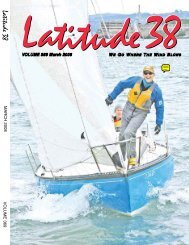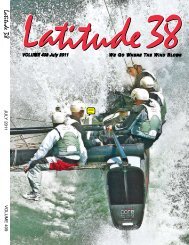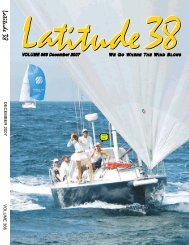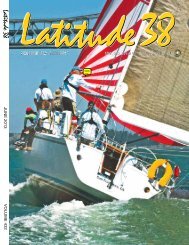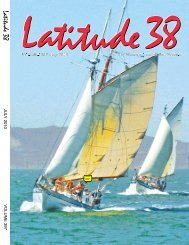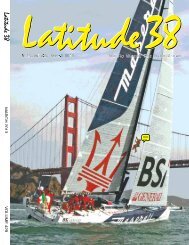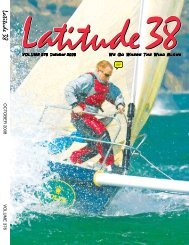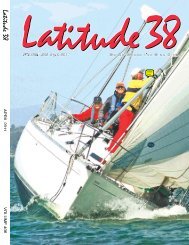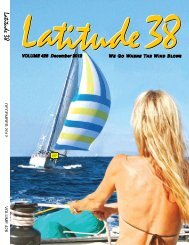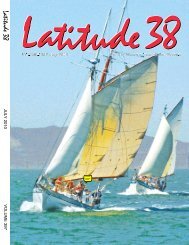October 2009 eBook all pages (free PDF, 36.6 - Latitude 38
October 2009 eBook all pages (free PDF, 36.6 - Latitude 38
October 2009 eBook all pages (free PDF, 36.6 - Latitude 38
Create successful ePaper yourself
Turn your PDF publications into a flip-book with our unique Google optimized e-Paper software.
IDIOT'S GUIDE<br />
Despite several advances in offshore<br />
voice communications such as<br />
satphones, marine single sideband (SSB)<br />
isn't going away anytime soon. That's<br />
because SSB, unlike satphones, <strong>all</strong>ows<br />
an unlimited number of people to listen<br />
to a transmission at the same time.<br />
As such, SSB is the only way to go<br />
for the various regional cruising nets,<br />
such as the Baja, Sonrisa, Chubasco<br />
and Southbound. It means that when<br />
Don Anderson of Summer Passage, for<br />
example, transmits his latest weather<br />
forecast, anyone who wants to can listen<br />
at the same time. When someone has a<br />
question about the forecast, everyone can<br />
hear the question and Don's response.<br />
Marine SSB is also perfect for cruising<br />
events such as the Baja Ha-Ha, the<br />
Caribbean 1500 and the Atlantic R<strong>all</strong>y<br />
for Cruisers. "While the Ha-Ha doesn't<br />
require SSB radio," advises the Grand<br />
Poobah, "most boats do have them.<br />
They're good for safety — but fun, too.<br />
The folks with SSBs are able to actively<br />
participate in <strong>all</strong> the roll c<strong>all</strong>s, weather<br />
and fishing reports, and other fleet news.<br />
Over a period of nearly two weeks, personalities<br />
develop over the radio, and<br />
an even greater sense of community is<br />
established."<br />
In racing events such as the TransPac,<br />
Pacific Cup, and Singlehanded TransPac,<br />
it offers more than just straight communication.<br />
"Thanks to marine SSB,<br />
our 1700 hour reports and discussions<br />
maintain the racing camaraderie and<br />
fun," notes Jack McGuire, KG6CJN,<br />
communications chairman of the '08<br />
Pacific Cup race.<br />
Although not the subject of this article,<br />
the other significant benefit of SSBs<br />
is that, when used with a Pactor modem<br />
and SailMail, they <strong>all</strong>ow for the transmission<br />
and reception of short emails while<br />
offshore.<br />
Licensing<br />
You don't need to pass a Ham radio<br />
operator's test to use a marine SSB. All<br />
that's required is a valid Ship Station<br />
license and a lifetime Restricted Radiotelephone<br />
Operator's permit. No testing<br />
required! The Ship Station license is good<br />
for 10 years and is non-transferable. If<br />
you're good at dealing with online government<br />
forms, you can apply for a license<br />
at http://wireless.fcc.gov. If you're not so<br />
good at it, or don't want to take the time,<br />
my lovely wife Suzie will be happy to help<br />
for a fee: (714) 549-5000.<br />
How does Ham (amateur radio) differ<br />
from SSB? If you're new to long distance<br />
marine radio, I suggest not even worrying<br />
about it. Although I run the Radio School<br />
and some of<br />
the income<br />
comes from<br />
t e a c h i n g<br />
s t u d e n t s<br />
how to use<br />
Ham radio<br />
and pass the test, I gener<strong>all</strong>y discourage<br />
new SSB operators from taking that<br />
step right away. Get the no-test license<br />
for SSB radio, become familiar with the<br />
procedures and protocols, and use it<br />
for a few months. If you find that you're<br />
one of the very few cruisers who talks<br />
on the radio so much that SSB frequencies<br />
aren't adequate, then look into Ham<br />
radio. Or if you're going to the South<br />
Pacific, where there's lots more traffic<br />
on ship-to-ship channels, you might<br />
consider eventu<strong>all</strong>y moving up to Ham<br />
status. But gener<strong>all</strong>y speaking, it's re<strong>all</strong>y<br />
only for serious radio buffs.<br />
By the way, there is nothing to prevent<br />
folks with SSB radios from listening on<br />
Ham frequencies, and indeed, there are<br />
some helpful Ham-only weather broadcasts.<br />
If you're worried that you might<br />
accidently stumble onto a Ham-only<br />
frequency, start transmitting, and re<strong>all</strong>y<br />
piss off the 'radio police', fear not. SSB<br />
radios that are capable of working Ham<br />
frequencies come 'locked' from the fac-<br />
For cruisers in California and Mexico,<br />
you'll almost exclusively use just five of them:<br />
4A, 4B, 4C, 8A and 8B.<br />
Page 104 • <strong>Latitude</strong> <strong>38</strong> • <strong>October</strong>, <strong>2009</strong><br />
In the realm of cruising, an SSB radio is a<br />
lifeline, an email gateway, and a hub of friendly<br />
conversation, like an old-fashioned party line.<br />
tory. Some can only be unlocked using<br />
software, while others can be unlocked<br />
by simply pressing three keys at the<br />
same time. In cases of genuine emergencies,<br />
Ham frequencies can be used even<br />
by people who don't have a license.<br />
How Far On What Bands?<br />
A marine SSB system operates on a<br />
marine radio spectrum c<strong>all</strong>ed shortwave,<br />
medium frequency and high frequency<br />
— 2 MHz-26 MHz. This radio spectrum<br />
is shared with hundreds of other radio<br />
users including shortwave broadcasts,<br />
Ham radio, FEMA, the American Red<br />
Cross and long-range aircraft.<br />
Radio signals within the SSB shortwave<br />
spectrum refract off the ionosphere<br />
and come back to earth hundreds or<br />
thousands of miles away without the<br />
need for communication satellites and/<br />
or ground stations. Each marine SSB<br />
radio frequency band has a very predictable<br />
skywave bounce bulls-eye. If you<br />
choose a band that's too high, your signal<br />
will skip over the other station. If you<br />
choose a frequency that's too low, your<br />
signal won't go far enough to reach.<br />
The following is a good guide for<br />
choosing the band of frequencies that<br />
will target your first skywave bounce:<br />
2 MHz ...............200-400 miles<br />
4 MHz ...............400-600 miles<br />
6 MHz ...............600-1,200 miles<br />
8 MHz ...............800-1,600 miles<br />
12 MHz .............1,200-2,400 miles<br />
16 MHz .............1,600-3,200 miles<br />
22 MHz .............2,200-4,000 miles plus<br />
26 MHz .............unpredictable during<br />
our solar cycle minimum<br />
Pop Quiz #1: You are in San Francisco<br />
and you want to talk with your buddy<br />
who's on his boat 1,200 miles away in<br />
Cabo San Lucas. Which band on marine<br />
SSB might you choose?<br />
Answer: Because 4, 6, and 8 MHz<br />
would likely f<strong>all</strong> short on the first radio<br />
signal bounce, 12 MHz and 16 MHz<br />
would likely be your best choices.<br />
The thing that usu<strong>all</strong>y drives new<br />
SSB operators nuts — and I know that it



